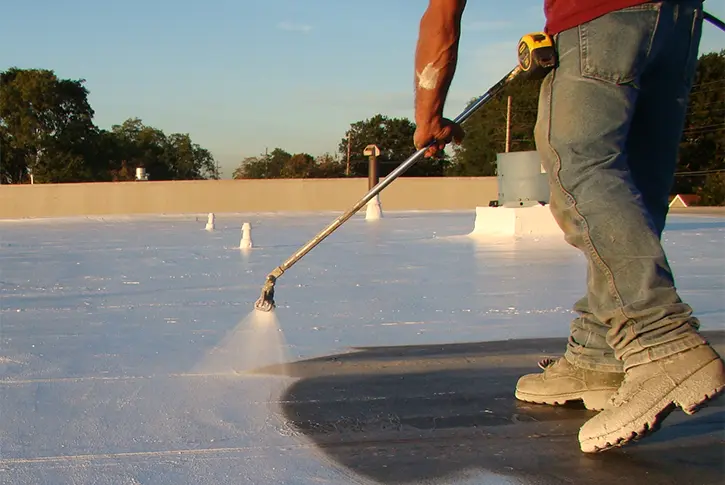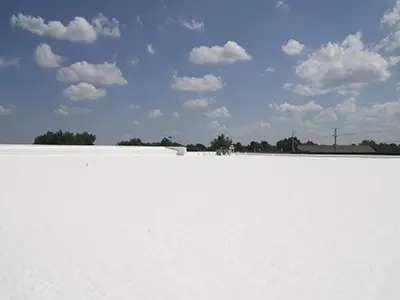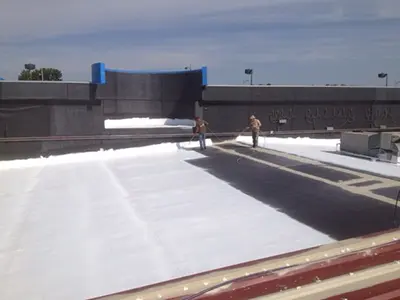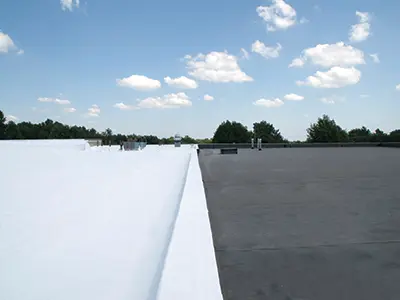
In Nebraska’s challenging climate, commercial property owners face unique roofing challenges from scorching summers to frigid winters and everything in between. Fluid-applied roofing systems have emerged as a game-changing solution that’s transforming how business owners approach roof maintenance and replacement.
A.G. Roof Coatings stands at the forefront of fluid-applied roofing systems. Serving locations throughout Nebraska, it is our goal to be your long-term commercial roofing partner. Call 402-919-5793 today and schedule your consultation.
Fluid-Applied Roofing Attributes
These innovative systems offer remarkable benefits that traditional roofing methods simply can’t match, especially in the Cornhusker State’s demanding environment. Let’s explore the five key reasons why fluid-applied roof coatings are revolutionizing the commercial roofing industry.
1. Exceptional Cost-Effectiveness
Fluid-applied roof coatings deliver significant cost savings for Nebraska commercial property owners compared to traditional roof replacement. With installation costs typically 50-70% less than a complete tear-off and replacement, these systems eliminate the need for expensive tear-offs, reducing labor costs and minimizing business disruption during Nebraska’s limited optimal construction season. Additionally, many coating systems qualify for valuable Nebraska state and local utility incentives due to their energy-efficient properties, including programs through Nebraska Public Power District and Omaha Public Power District, further enhancing their financial appeal for budget-conscious Midwest businesses.
2. Extended Roof Lifespan in Nebraska’s Extreme Climate
Nebraska’s dramatic temperature swings, from sub-zero winters to triple-digit summer heat, put extraordinary stress on commercial roofing systems. One of the most compelling advantages of fluid-applied coatings in this harsh environment is their ability to dramatically extend the service life of existing roof systems. These coatings create a seamless, waterproof membrane that protects the underlying roof structure from Nebraska’s intense UV exposure, frequent hailstorms, and extreme thermal cycling. By addressing small issues before they become major problems, a quality coating system can add 10-20 years to your roof’s functional lifespan in the Nebraska climate, delaying the need for costly replacement and providing excellent resistance to the freeze-thaw cycles that plague Midwestern commercial buildings.
3. Superior Energy Efficiency
Reflective fluid-applied roof coatings significantly reduce Nebraska building cooling costs during the state’s brutally hot summers by minimizing solar heat absorption. These “cool roof” solutions can lower roof surface temperatures by up to 50-60°F during peak Nebraska summer conditions (which regularly exceed 90°F in July and August), dramatically reducing the urban heat island effect in metropolitan areas like Omaha and Lincoln while decreasing interior temperatures and HVAC loads. Many Nebraska building owners report energy savings of 10-30% after installation, particularly valuable given the region’s rising electricity costs. The reflective properties also help shed snow load during winter months, providing year-round climate management benefits uniquely suited to Nebraska’s diverse seasonal challenges.
4. Seamless Waterproofing Protection
Nebraska’s unpredictable precipitation patterns, from heavy spring thunderstorms to winter ice damming, demand superior waterproofing solutions. Unlike traditional roofing systems with numerous seams and penetrations that create potential failure points, fluid-applied coatings form a completely seamless, monolithic membrane ideal for handling Nebraska’s moisture challenges. This continuous protection eliminates vulnerable joints and flashing details that typically cause leaks in conventional roofing during the state’s frequent thunderstorms and heavy snowmelt. The elastomeric properties of these coatings specifically benefit Nebraska buildings by allowing them to expand and contract with the extreme temperature fluctuations common in the Great Plains, maintaining their protective integrity through thermal cycling from -10°F winter days to 100°F summer afternoons—temperature swings that conventional roofing struggles to withstand.
5. Simplified Installation and Minimal Disruption
The non-invasive application process of fluid roof coatings represents a major advantage for Nebraska businesses that cannot afford operational downtime during the state’s already short construction season. Installation requires no loud equipment, produces minimal odor, and creates substantially less waste than traditional tear-offs, particularly valuable in areas with limited construction waste facilities across Nebraska’s smaller communities. The application process is typically quiet enough that building occupants can continue normal operations during installation. This significant reduction in business disruption translates to preserved productivity and revenue during roof restoration projects, a crucial consideration for Nebraska’s agricultural processing facilities, distribution centers, and other operations that cannot pause for extensive roofing projects.
The Sustainable Choice for Nebraska’s Modern Buildings
Beyond these primary benefits, fluid-applied roof coatings represent an environmentally responsible choice perfectly aligned with Nebraska’s growing focus on sustainability. By extending the life of existing roofing materials and reducing landfill waste from tear-offs, these systems support Nebraska’s waste reduction goals and limited landfill capacity. Their reflective properties contribute to reduced carbon emissions through energy savings, supporting Nebraska’s renewable energy initiatives and the state’s significant wind power investments. For Nebraska businesses pursuing LEED certification or participating in local sustainability programs in Omaha, Lincoln, and other forward-thinking communities, fluid-applied coatings offer valuable points toward green building certification while creating a more sustainable building envelope suited to the prairie state’s environmental conditions.
For Nebraska commercial property owners seeking cost-effective, durable, and environmentally sound roofing solutions adapted to the state’s unique climate challenges, fluid-applied roof coatings offer compelling advantages that are truly revolutionizing the industry across the Cornhusker State. With their unique combination of performance benefits specifically suited to Nebraska’s extreme temperatures, seasonal precipitation patterns, and short construction season, these innovative systems represent the future of commercial roof maintenance and restoration from Scottsbluff to Omaha.
To learn more about fluid-applied roofing systems, call 402-919-5793 and speak with one of our experts.
FAQ
How long do fluid-applied roof coatings typically last in Nebraska?
Quality fluid-applied roof coatings in Nebraska typically last 10-18 years depending on the specific product, application thickness, local environmental conditions, and maintenance practices. Premium silicone and high-solids coatings often perform best in Nebraska’s climate, reaching the upper end of this range, while acrylic coatings may require recoating sooner due to Nebraska’s freeze-thaw cycles and intense UV exposure. Buildings in western Nebraska’s more arid climate often see longer coating lifespans than those in the more humid eastern regions near the Missouri River.
Can fluid-applied coatings be installed year-round in Nebraska?
Nebraska’s seasonal climate limits optimal installation windows, with most manufacturers recommending application when temperatures are between 50-90°F with low humidity and no precipitation forecasted for 24-48 hours. This typically restricts prime installation season to late April through early October in most Nebraska locations. Some advanced formulations specifically marketed for Midwestern climates offer expanded application windows, but temperature and moisture considerations remain critical for proper curing and adhesion. Many Nebraska commercial roofing contractors recommend scheduling installations in early summer to avoid both spring thunderstorm season and the intense heat of late July and August.
Are all fluid-applied roof coatings reflective enough for Nebraska’s summer heat?
Not all coatings are equally suited to Nebraska’s intense summer sun. While white coatings offer maximum solar reflectance (typically 80-88%) ideal for Nebraska’s hot summers, many manufacturers also offer colored options with moderate reflectivity that may be appropriate for buildings in partially shaded locations or northern Nebraska. For maximum energy efficiency benefits during Nebraska’s peak cooling season (when temperatures consistently exceed 85°F), local commercial roofing experts recommend products with high Solar Reflectance Index (SRI) values certified by the Cool Roof Rating Council. Nebraska-based contractors typically recommend SRI values above 100 for optimal performance in the state’s continental climate zone.
Do fluid-applied coatings work on all common commercial roof types?
Fluid-applied systems are remarkably versatile for Nebraska’s diverse commercial building stock, with successful applications across the state on most commercial roofing substrates including the metal roofing common on agricultural facilities, modified bitumen popular on older Omaha office buildings, BUR systems prevalent in Lincoln’s government buildings, single-ply membranes widely used on retail developments, and concrete decks found in institutional settings. However, Nebraska’s extreme temperature fluctuations make proper substrate preparation and primer selection especially critical, as different roof types require specific coating formulations and application techniques optimized for the state’s climate zone. Nebraska contractors with specialized experience in the region’s conditions can provide crucial guidance on system selection.
What maintenance do coated roofs require in Nebraska’s climate?
Nebraska’s seasonal extremes demand specialized maintenance approaches for coated roofs. Best practices include bi-annual inspections (ideally in spring after winter weather and fall before snow season), clearing of debris and cottonwood tree fluff common across the state, thorough cleaning of drains before thunderstorm season, and prompt repair of any hail damage, particularly important in Nebraska’s active storm corridor. Nebraska-specific maintenance should also include snow load assessment after major winter storms and checking for ice dam formation in roof transitions. Most manufacturers recommend Nebraska building owners schedule gentle cleaning with low-pressure washing every 2 years (more frequently than in milder climates) to maintain reflectivity against Nebraska’s high UV index and remove accumulated agricultural dust and pollen that could degrade coating performance.




